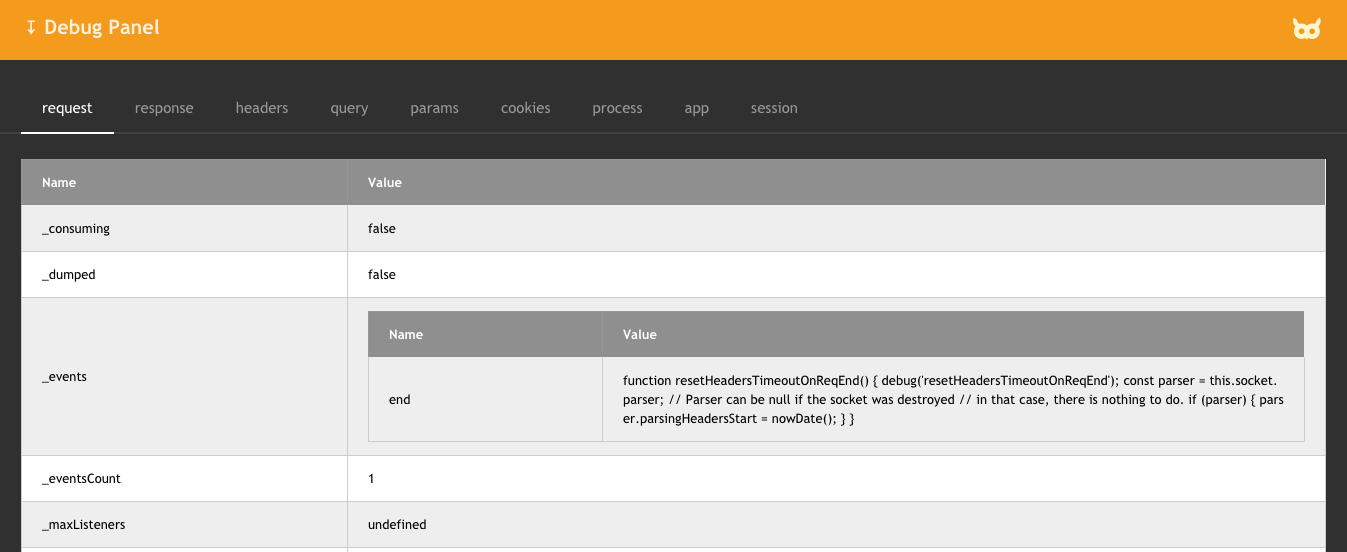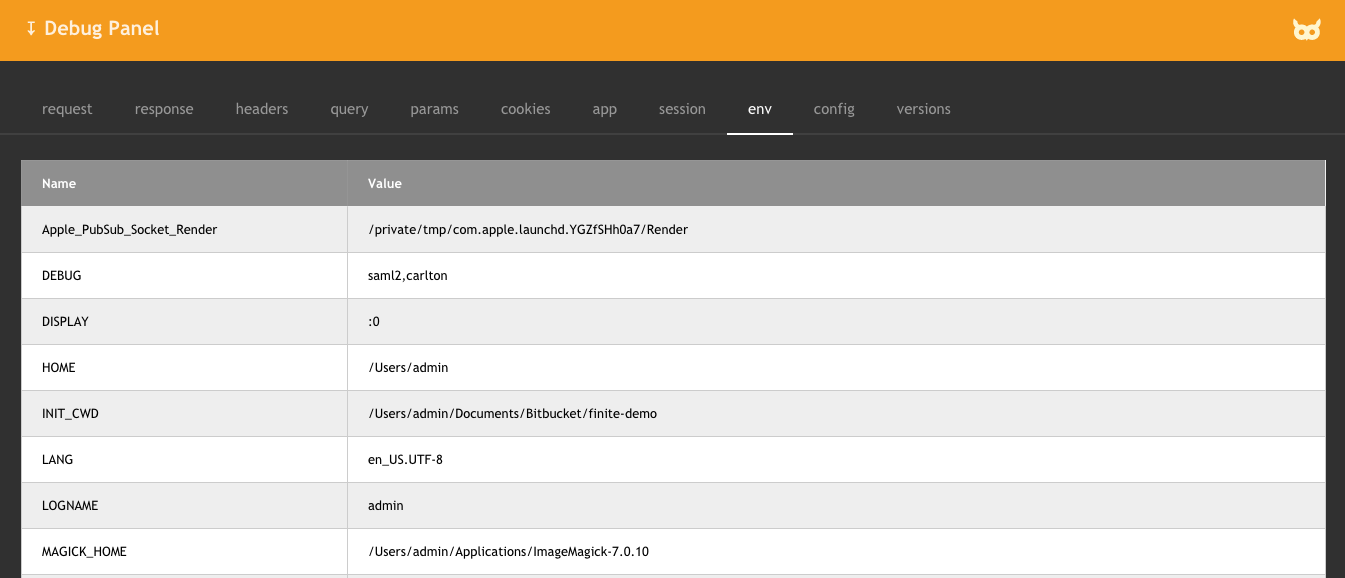express-debug-panel v1.0.5
express-debug-panel
A panel containing useful debugging information, for use in Express.js applications.
Examples
The Debug Panel is initially displayed in collapsed form:

When you click on it, it opens in its default format:

In this default format, it shows information for the following Express.js and Node.js objects:
You can also provide a custom format for the Debug Panel. In the following screenshot, we have suppressed the process object and replaced it with env, config, and versions objects.

Demonstration
See a live demonstration of the Debug Panel at demo.finitewisdom.com.
Installation
$ npm install express-debug-panelUse
The Debug Panel works with all Express.js template engines. Here are the instructions for the three most popular engines:
Use with EJS
To add a Debug Panel to the /test route of your Express.js application that utilizes EJS templates, use the following code:
const
debugPanel = require( "express-debug-panel" ),
debugPanelOptions = null;
function get( req, res ) {
res.render( "test.ejs", {
"req": req,
"debugPanel": debugPanel,
"debugPanelOptions": debugPanelOptions
} );
}
function addRoutes( router ) {
router.get( "/test", get );
}
exports.addRoutes = addRoutes;In your test.ejs view, include the following code:
<%
if ( process.env.NODE_ENV.toLowerCase() !== "production" ) {
debugPanel.render( req, debugPanelOptions, ( err, html ) => { %>
<%- err ? JSON.stringify( err ) : html %> <%
} );
}
%>Use with Pug
To add a Debug Panel to the /test route of your Express.js application that utilizes Pug templates, use the following code:
const
debugPanel = require( "express-debug-panel" ),
debugPanelOptions = null;
function get( req, res ) {
res.render( "test.pug", {
"req": req,
"debugPanel": debugPanel,
"debugPanelOptions": debugPanelOptions
} );
}
function addRoutes( router ) {
router.get( "/test", get );
}
exports.addRoutes = addRoutes;In your test.pug view, include the following code:
- if ( process.env.NODE_ENV.toLowerCase() !== "production" )
- debugPanel.render( req, debugPanelOptions, ( err, html ) => {
!= err ? JSON.stringify( err ) : html
- } );Use with Mustache
To add a Debug Panel to the /test route of your Express.js application that utilizes Mustache templates, use the following code:
const
debugPanel = require( "express-debug-panel" ),
debugPanelOptions = null;
function get( req, res ) {
if ( process.env.NODE_ENV.toLowerCase() !== "production" ) {
debugPanel.render( req, debugPanelOptions, ( err, html ) => {
res.render( "test.mst", {
"req": req,
"debugPanelOutput": ( err || html )
} );
} );
} else {
res.render( "test.mst", {
"req": req,
"debugPanelOutput": null
} );
}
}
function addRoutes( router ) {
router.get( "/test", get );
}
exports.addRoutes = addRoutes;In your test.mst view, include the following code:
{{{ debugPanelOutput }}}Configuration
You can configure what is displayed in the Debug Panel by passing an options object as the 2nd argument to debugPanel.render. The options object takes the following form:
{
"name": {
"object": obj,
"maxDepth": 2,
"display": true
},
...
}where:
- name is the name of the tab within the Debug Panel
- obj is the object to display
- maxDepth is the maximum depth that will be displayed for nested objects
- display indicates whether to include this tab within the Debug Panel
The default configuration for the Debug Panel is:
{
"request": {
"object": req,
"maxDepth": 2,
"display": true
},
"response": {
"object": req.res,
"maxDepth": 2,
"display": true
},
"headers": {
"object": req.headers,
"maxDepth": 1,
"display": true
},
"query": {
"object": req.query,
"maxDepth": 1,
"display": true
},
"params": {
"object": req.params,
"maxDepth": 1,
"display": true
},
"cookies": {
"object": req.cookies,
"maxDepth": 1,
"display": true
},
"process": {
"object": process,
"maxDepth": 3,
"display": true
},
"app": {
"object": req.app,
"maxDepth": 4,
"display": true
},
"session": {
"object": req.session,
"maxDepth": 3,
"display": true
}
}As an example, let's say that we wanted to configure the Debug Panel to suppress the process tab and replace it with three others:
- env
- config
- versions
To do so, we would define an options object of the form:
{
"process": {
"display": false
},
"env": {
"object": process.env,
"maxDepth": 1,
"display": true
},
"config": {
"object": process.config,
"maxDepth": 3,
"display": true
},
"versions": {
"object": process.versions,
"maxDepth": 1,
"display": true
}
}We would then replace this code:
const
debugPanel = require( "express-debug-panel" ),
debugPanelOptions = null;with this code:
const
debugPanel = require( "express-debug-panel" ),
debugPanelOptions = {
"process": {
"display": false
},
"env": {
"object": process.env,
"maxDepth": 1,
"display": true
},
"config": {
"object": process.config,
"maxDepth": 3,
"display": true
},
"versions": {
"object": process.versions,
"maxDepth": 1,
"display": true
}
};License
(The MIT License)
Copyright (c) 2020 Finite Wisdom j@wiz4.us
Permission is hereby granted, free of charge, to any person obtaining a copy of this software and associated documentation files (the 'Software'), to deal in the Software without restriction, including without limitation the rights to use, copy, modify, merge, publish, distribute, sublicense, and/or sell copies of the Software, and to permit persons to whom the Software is furnished to do so, subject to the following conditions:
The above copyright notice and this permission notice shall be included in all copies or substantial portions of the Software.
THE SOFTWARE IS PROVIDED 'AS IS', WITHOUT WARRANTY OF ANY KIND, EXPRESS OR IMPLIED, INCLUDING BUT NOT LIMITED TO THE WARRANTIES OF MERCHANTABILITY, FITNESS FOR A PARTICULAR PURPOSE AND NONINFRINGEMENT. IN NO EVENT SHALL THE AUTHORS OR COPYRIGHT HOLDERS BE LIABLE FOR ANY CLAIM, DAMAGES OR OTHER LIABILITY, WHETHER IN AN ACTION OF CONTRACT, TORT OR OTHERWISE, ARISING FROM, OUT OF OR IN CONNECTION WITH THE SOFTWARE OR THE USE OR OTHER DEALINGS IN THE SOFTWARE.
